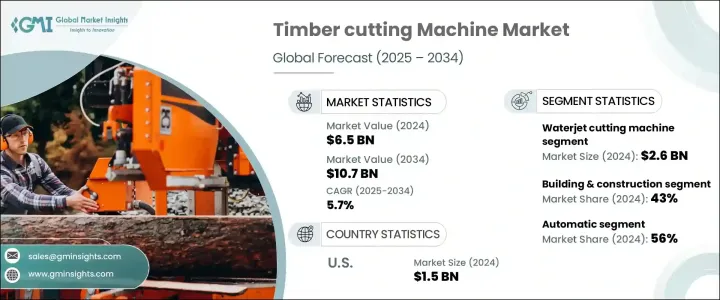
|
시장보고서
상품코드
1716524
목재 절단기 시장 : 기회, 성장 촉진요인, 산업 동향 분석 및 예측(2025-2034년)Timber Cutting Machine Market Opportunity, Growth Drivers, Industry Trend Analysis, and Forecast 2025 - 2034 |
||||||
세계의 목재 절단기 시장은 2024년에는 65억 달러로 평가되었고, 2025년부터 2034년까지 연평균 성장률(CAGR) 5.7%로 성장할 것으로 예측됩니다.
목재 및 목재 제품에 대한 수요 증가와 목재 가공 및 산림 관리에 대한 투자 증가가 시장 확대를 주도하고 있습니다. 목재는 목공 산업에서 중요한 역할을 하며 들보, 바닥재, 판넬, 가구 제작에 널리 사용됩니다. 도시화와 인프라 프로젝트가 계속 증가함에 따라 목재 제품에 대한 수요가 증가하여 효율적인 목재 절단기의 판매가 증가하고 있습니다. 특히 개발도상국을 중심으로 가구 시장이 확대되면서 대량 생산을 위한 목재 절단 기술에 대한 수요가 증가하고 있습니다. 또한 목재 수출이 증가함에 따라 수출 시장을 위해 대량의 목재를 가공할 수 있는 기계가 필요합니다. 합판, 베니어 및 건축용 목재를 포함한 가공 목재에 대한 수요도 증가하고 있어 첨단 절단 기술의 채택이 증가하고 있습니다.

2024년 워터젯 절단기 부문은 26억 달러의 매출로 시장을 주도했습니다. 한편, 레이저 절단기 부문은 2034년까지 6.1%의 연평균 성장률로 주목할 만한 성장을 보일 것으로 예상됩니다. 레이저 커팅 기술은 탁월한 정밀도와 품질을 제공하여 현대 목공에서 매우 유용한 도구입니다. 이 기술은 재료 손실을 최소화하면서 깔끔하게 절단할 수 있어 복잡한 패턴과 작은 디테일에 이상적입니다. 고급 레이저 기술은 다양한 종류와 두께의 목재를 처리할 수 있어 목공 작업에 다양성을 더합니다. 절단 외에도 새로 개발된 레이저 시스템은 목재에 조각과 마킹을 할 수 있어 복잡한 디자인, 질감, 로고를 만들 수 있습니다.
| 시장 범위 | |
|---|---|
| 시작 연도 | 2024년 |
| 예측 연도 | 2025-2034년 |
| 시작 금액 | 65억 달러 |
| 예측 금액 | 107억 달러 |
| CAGR | 5.7% |
건축 및 건설 부문은 2024년 목재 절단기 시장의 약 43%를 차지했습니다. 개발도상국의 급속한 도시화와 산업화로 인해 구조용 및 실내 장식용 목재에 대한 수요가 증가하고 있습니다. 아시아태평양과 같은 지역의 건설 활동 증가는 이 부문의 성장에 크게 기여하고 있습니다. 목재 가구 산업도 목재 절단에서 자동화와 정밀화로 전환하고 있습니다. 제조업체들은 맞춤형의 지속 가능한 목재 가구에 대한 수요 증가를 충족하기 위해 첨단 기계를 도입하여 생산성을 높이고 자재 낭비를 최소화하고 있습니다. 이러한 추세는 기술 혁신이 계속해서 산업을 형성하고 고품질의 친환경 가구에 대한 소비자의 요구를 해결함에 따라 지속될 것으로 예상됩니다.
자동 부문은 높은 정밀도를 제공하는 첨단 시스템에 대한 선호도가 높아짐에 따라 2024년 목재 절단기 시장의 약 56%를 차지할 것으로 예상됩니다. 자동 절단기는 자재 낭비를 최소화하고 비용을 절감하여 효율성을 향상시킵니다. 이러한 시스템은 자재 유형, 수량, 치수에 대한 필수 데이터를 수집하여 특수 소프트웨어를 통해 자재 사용을 최적화하고 생산성을 향상시킬 수 있습니다. 자동화된 기계는 단판 절단 공정에서 뛰어난 성능을 발휘하도록 설계되었으며 컨베이어 및 정적 설정 모두에서 사용할 수 있습니다.
2024년 미국은 북미 목재 절단기 시장에서 약 80%의 점유율을 차지하고 15억 달러의 수익을 창출하며 북미 목재 절단기 시장을 지배했습니다. 미국 시장의 확대는 기술 발전, 목재 및 목재 기반 제품에 대한 수요 증가, 목재 수출 증가에 힘입은 결과입니다. 미국은 산업용 원목 생산, 목재 펄프, 목재 펠릿, 제재목 분야에서 글로벌 리더로서 시장에서의 입지를 더욱 공고히 하고 있습니다.
목차
제1장 조사 방법과 조사 범위
제2장 주요 요약
제3장 업계 인사이트
- 생태계 분석
- 밸류체인에 영향을 주는 요인
- 이익률 분석
- 혁신
- 장래의 전망
- 제조업자
- 유통업체
- 공급자의 상황
- 기술적 전망
- 주유
- 규제 상황
- 영향요인
- 성장 촉진요인
- 목재 및 목재 제품에 대한 수요 증가
- 목재 가공 및 수출 증가
- 업계의 잠재적 위험 및 과제
- 높은 초기 투자 비용
- 높은 유지 보수 비용
- 성장 촉진요인
- 성장 가능성 분석
- Porter's Five Forces 분석
- PESTEL 분석
제4장 경쟁 구도
- 소개
- 기업 점유율 분석
- 경쟁 포지셔닝 매트릭스
- 전략 전망 매트릭스
제5장 시장 추계 및 예측 : 기계 기술별(2021-2034년)
- 주요 동향
- 레이저 절단기
- 밀링 커터
- 워터젯 절단기
- 톱 절단기
제6장 시장 추계 및 예측 : 동작 메커니즘별(2021-2034년)
- 주요 동향
- 자동
- 반자동
- 수동
제7장 시장 추계 및 예측 : 기계 설치별(2021-2034년)
- 주요 동향
- 수평
- 수직
제8장 시장 추계 및 예측 : 최종 이용 산업별(2021-2034년)
- 주요 동향
- 가구 제조
- 건축 및 건설
- 임업 및 벌채
- 기타(종이 펄프, 포장 등)
제9장 시장 추계 및 예측 : 유통 채널별(2021-2034년)
- 주요 동향
- 직접 판매
- 간접 판매
제10장 시장 추계 및 예측 : 지역별(2021-2034년)
- 주요 동향
- 북미
- 미국
- 캐나다
- 유럽
- 영국
- 독일
- 프랑스
- 이탈리아
- 스페인
- 러시아
- 아시아태평양
- 중국
- 인도
- 일본
- 한국
- 호주
- 라틴아메리카
- 브라질
- 멕시코
- 중동 및 아프리카
- UAE
- 사우디아라비아
- 남아프리카
제11장 기업 프로파일
- Bezner-Oswald
- Gelgoog Company
- Homag
- Kikukawa Enterprise
- Mebor
- Michael Weinig
- Nihar Industries
- Salvador
- Salvamac
- SCM
- Socomec
- TL Pathak
- Umaboy
- Walter Werkzeuge
- Weho Machinery
The Global Timber Cutting Machine Market was valued at USD 6.5 billion in 2024 and is projected to expand at a CAGR of 5.7% from 2025 to 2034. The growing demand for wood and timber products, along with increased investment in timber processing and forest management, is driving market expansion. Timber plays a crucial role in the woodwork industry, being widely used for making beams, flooring, paneling, and furniture. As urbanization and infrastructure projects continue to grow, the need for timber products is increasing, driving the sales of efficient timber cutting machines. The expanding furniture market, especially in developing nations, is contributing to the demand for wood cutting technologies for high-volume production. Additionally, rising timber exports require machines capable of processing large volumes of wood for export markets. Demand is also rising for processed wood materials, including plywood, veneer, and construction timber, which is boosting the adoption of advanced cutting technologies.

In 2024, the waterjet cutting machine segment led the market with revenues of USD 2.6 billion. Meanwhile, the laser cutting machine segment is predicted to witness notable growth at a CAGR of 6.1% through 2034. Laser cutting technology offers exceptional precision and quality, making it a valuable tool in modern woodworking. This technology provides clean cuts with minimal material loss, making it ideal for intricate patterns and small details. Advanced laser technology can handle different types and thicknesses of wood, adding versatility to woodworking applications. Apart from cutting, newly developed laser systems can also engrave and mark wood, enabling the creation of intricate designs, textures, and logos.
| Market Scope | |
|---|---|
| Start Year | 2024 |
| Forecast Year | 2025-2034 |
| Start Value | $6.5 Billion |
| Forecast Value | $10.7 Billion |
| CAGR | 5.7% |
The building and construction segment accounted for approximately 43% of the timber cutting machine market in 2024. Rapid urbanization and industrialization in developing economies are driving the demand for wood in structural applications and interior decor. Rising construction activity in regions such as Asia-Pacific is contributing significantly to the growth of this segment. The wood furniture industry is also experiencing a shift toward automation and precision in timber cutting. Manufacturers are adopting advanced machinery to meet the growing need for customized and sustainable wooden furniture, enhancing productivity and minimizing material waste. This trend is expected to persist as technological innovations continue to shape the industry and address consumer demands for high-quality and environmentally friendly furniture.
The automatic segment captured around 56% of the timber cutting machine market in 2024 due to the growing preference for advanced systems that offer high precision. Automated cutting machines improve efficiency by minimizing material waste and cutting costs. These systems collect essential data on material type, quantity, and dimensions, allowing specialized software to optimize material usage and enhance productivity. Automated machines are designed for superior performance in single-ply cutting processes and can be used in both conveyor and static setups.
In 2024, the United States dominated the North American timber cutting machine market, holding around 80% of the region's share and generating USD 1.5 billion in revenue. The expansion of the U.S. market is fueled by technological advancements, increased demand for wood and timber-based products, and rising wood exports. The U.S. remains a global leader in industrial roundwood production, wood pulp, wood pellets, and sawn wood, further reinforcing its position in the market.
Table of Contents
Chapter 1 Methodology & Scope
- 1.1 Market scope & definitions
- 1.2 Base estimates & calculations
- 1.3 Forecast calculations.
- 1.4 Data sources
- 1.4.1 Primary
- 1.4.2 Secondary
- 1.4.2.1 Paid sources
- 1.4.2.2 Public sources
Chapter 2 Executive Summary
- 2.1 Industry synopsis, 2021-2034
Chapter 3 Industry Insights
- 3.1 Industry ecosystem analysis
- 3.1.1 Factor affecting the value chain.
- 3.1.2 Profit margin analysis.
- 3.1.3 Disruptions
- 3.1.4 Future outlook
- 3.1.5 Manufactures
- 3.1.6 Distributors
- 3.2 Supplier landscape
- 3.3 Technological landscape
- 3.4 Key news & initiatives
- 3.5 Regulatory landscape
- 3.6 Impact forces
- 3.6.1 Growth drivers
- 3.6.1.1 Rising demand for wood and timber products
- 3.6.1.2 Increase in timber processing and export
- 3.6.2 Industry pitfalls & challenges
- 3.6.2.1 High initial investment
- 3.6.2.2 High maintenance cost
- 3.6.1 Growth drivers
- 3.7 Growth potential analysis
- 3.8 Porter's analysis
- 3.9 PESTEL analysis
Chapter 4 Competitive Landscape, 2024
- 4.1 Introduction
- 4.2 Company market share analysis
- 4.3 Competitive positioning matrix
- 4.4 Strategic outlook matrix
Chapter 5 Market Estimates & Forecast, By Machine Technology, 2021-2034 (USD Billion) (Thousand Units)
- 5.1 Key trends
- 5.2 Laser cutting machine
- 5.3 Milling cutting machine
- 5.4 Waterjet cutting machine
- 5.5 Saw cutting machine
Chapter 6 Market Estimates & Forecast, By Operating Mechanism, 2021-2034 (USD Billion) (Thousand Units)
- 6.1 Key trends
- 6.2 Automatic
- 6.3 Semi-automatic
- 6.4 Manual
Chapter 7 Market Estimates & Forecast, By Machine Installation, 2021-2034 (USD Billion) (Thousand Units)
- 7.1 Key trends
- 7.2 Horizontal
- 7.3 Vertical
Chapter 8 Market Estimates & Forecast, By End Use Industry, 2021-2034 (USD Billion) (Thousand Units)
- 8.1 Key trends
- 8.2 Furniture manufacturing
- 8.3 Building & construction
- 8.4 Forestry and logging
- 8.5 Others (pulp & paper, packaging, etc.)
Chapter 9 Market Estimates & Forecast, By Distribution Channel, 2021-2034 (USD Billion) (Thousand Units)
- 9.1 Key trends
- 9.2 Direct sales
- 9.3 Indirect sales
Chapter 10 Market Estimates & Forecast, By Region, 2021-2034 (USD Billion) (Thousand Units)
- 10.1 Key trends
- 10.2 North America
- 10.2.1 U.S.
- 10.2.2 Canada
- 10.3 Europe
- 10.3.1 UK
- 10.3.2 Germany
- 10.3.3 France
- 10.3.4 Italy
- 10.3.5 Spain
- 10.3.6 Russia
- 10.4 Asia Pacific
- 10.4.1 China
- 10.4.2 India
- 10.4.3 Japan
- 10.4.4 South Korea
- 10.4.5 Australia
- 10.5 Latin America
- 10.5.1 Brazil
- 10.5.2 Mexico
- 10.6 MEA
- 10.6.1 UAE
- 10.6.2 Saudi Arabia
- 10.6.3 South Africa
Chapter 11 Company Profiles
- 11.1 Bezner-Oswald
- 11.2 Gelgoog Company
- 11.3 Homag
- 11.4 Kikukawa Enterprise
- 11.5 Mebor
- 11.6 Michael Weinig
- 11.7 Nihar Industries
- 11.8 Salvador
- 11.9 Salvamac
- 11.10 SCM
- 11.11 Socomec
- 11.12 T.L Pathak
- 11.13 Umaboy
- 11.14 Walter Werkzeuge
- 11.15 Weho Machinery



















